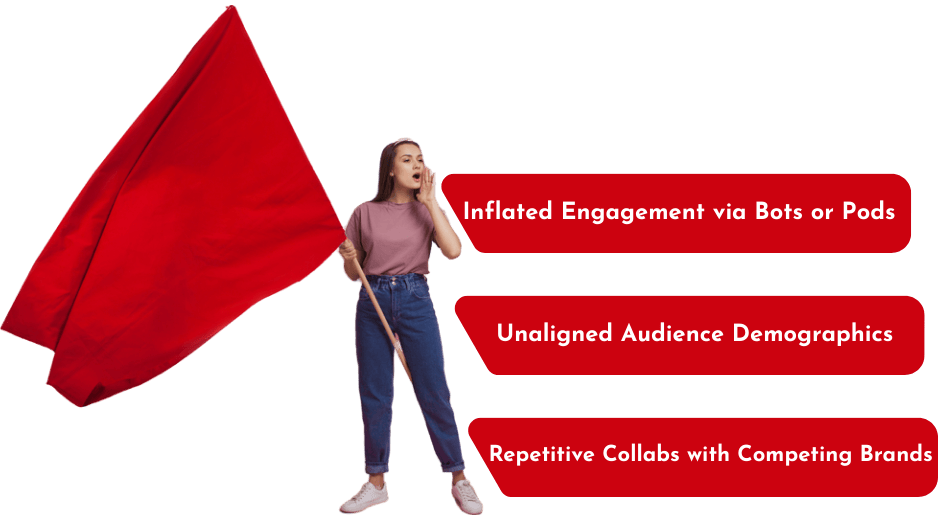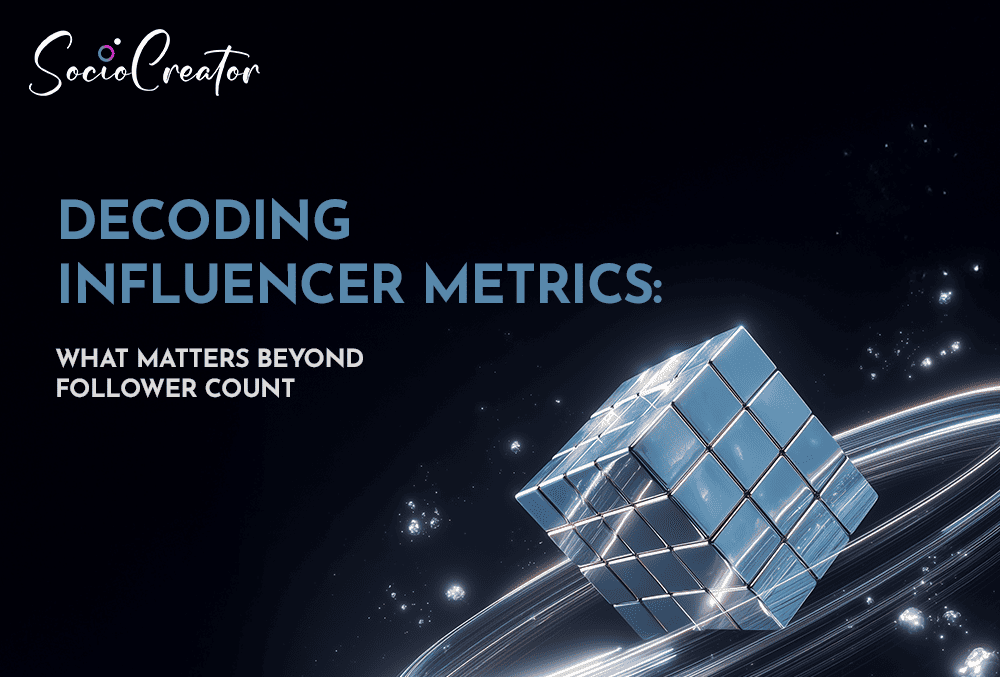We’ve all seen those profiles boasting massive follower counts. For a while, it felt like that was the golden ticket. But honestly? Those big numbers can be deceiving. As influencer marketers, we know that a million followers don’t automatically translate to a million dollars in sales or even a million engaged eyeballs on your brand. So, let’s pull back the curtain and talk about the influencer performance metrics that truly matter.
Why Follower Count Isn’t the Full Story Anymore
The Myth of Big Numbers
Think of it like this: would you rather have 100 people who are genuinely interested in what you’re selling, or 10,000 who just hit ‘follow’ and never interact? Exactly. That massive follower count might look impressive on paper, but if those followers aren’t your target audience, or worse, if they’re not even real people, what’s the point? This is why we need to look beyond the surface and understand how to evaluate influencers effectively.
The Real Cost of Chasing Vanity Metrics
Chasing after influencers solely based on follower count can actually cost you. You might end up spending your budget on an audience that isn’t receptive to your message, leading to poor campaign performance and a disappointing influencer ROI tracking. Time and resources are precious, and we can’t afford to waste them on metrics that don’t translate to tangible results.
What Today’s Brands Actually Care About
Smart brands in 2025 are laser-focused on impact. They want to see how influencer collaborations are actually moving the needle – driving website visits, generating leads, boosting sales, and building brand loyalty. This shift in focus means we, as marketers, need to be fluent in the best metrics for influencer marketing and understand influencer analytics for brands.
The Influencer Metrics That Actually Matter in 2025
So, what should we be looking at instead of just that big follower number? Here are the key influencer metrics beyond follower count that I pay close attention to:
Engagement Rate (and Why It’s Not Just a % Number)
Influencer engagement rate is a crucial indicator of how actively an audience interacts with a creator’s content. It’s usually calculated as the percentage of likes, comments, and shares relative to their follower count.
Engagement Rate = Number of Followers / Total Interactions (Likes + Comments + Shares + Saves) × 100%
However, it’s not just about the percentage. I dig deeper:
- Quality of Engagement: Are the comments genuine and thoughtful, or are they generic “great post!” type responses? Deep, meaningful engagement signals a more invested audience.
- Consistency: Is their engagement rate consistently healthy across their content, or are there suspicious spikes?
Audience Authenticity & Quality (Not Bots or Pods)
This is non-negotiable. A high follower count with low or inauthentic engagement is a major red flag. We need to assess the audience authenticity metrics. Tools and manual checks help us identify:
- Suspicious Follower Growth Patterns: Sudden, large increases in followers can indicate bot activity.
- Low Engagement Compared to Follower Count: A large audience with minimal interaction is a red flag.
- Generic or Bot-Like Comments: Repetitive or nonsensical comments often point to inauthentic engagement.
- Follower Demographics: Are the influencer’s followers aligned with your target audience’s demographics (age, location, interests)? This is a key aspect of audience demographics in influencer marketing.
Save Rate, Share Rate & Comment Depth
These metrics offer deeper insights into how valuable and resonant the content is to the audience:
- Save Rate: Indicates that the audience found the content valuable enough to save for later, suggesting a higher level of interest.
- Share Rate: Shows that the audience is willing to share the content with their own networks, amplifying reach and indicating strong resonance.
- Comment Depth: As mentioned earlier, the quality and length of comments reveal the level of genuine interest and connection the audience has with the influencer and their content.
Conversion Metrics – Clicks, Signups, Sales
Ultimately, we want to see if influencer campaigns are driving tangible results. This is where influencer ROI tracking comes in. We look at:
- Click-Through Rates (CTR): How many people are clicking on links shared by the influencer?
- Sign-ups and Leads: Are influencer campaigns generating valuable leads for your business?
- Sales and Revenue: The most direct measure of ROI are influencer collaborations leading to actual purchases?
Cost Per Action (CPA), ROI, and Attribution
To truly understand the effectiveness of an influencer, we need to calculate
- Cost Per Action (CPA): The cost associated with a specific action (e.g., a click, a signup, or a purchase) driven by the influencer. CPA = Number of Actions Campaign Cost
- Return on Investment (ROI): The overall profitability of the influencer campaign. ROI = Campaign Cost (Revenue Generated − Campaign Cost) × 100%
- Attribution: Understanding which influencer content and efforts are directly contributing to conversions. This often involves using unique tracking links and promo codes.
How to Evaluate Influencer Fit Before You Even Reach Out
Before you even think about numbers, consider these crucial qualitative factors to how to choose the right influencer:
Do They Match Your Brand Voice & Values?
Authenticity is key for both the influencer and the brand. Does their content style, tone, and overall message align with your brand’s personality and values? A mismatch can feel jarring and damage your brand reputation. This ties into brand alignment metrics.
Is Their Audience Aligned with Your Buyer Persona?
It’s not just about demographics; it’s about psychographics too. Do their followers share the interests, needs, and pain points of your ideal customer?
Are Their Followers Actually Engaged (Not Just Watching)?
Go beyond the engagement rate percentage and actually look at the interactions. Are people asking questions, sharing their experiences, and genuinely connecting with the content?
Have They Done Paid Collabs Before — and Performed Well?
Look at their past sponsored content. Was it well-integrated? Did it generate positive feedback? Don’t be afraid to ask for case studies or performance reports if available.
Tools & Tactics for Vetting Influencers Like a Pro
We’re not just relying on gut feeling here. There are tools and strategies to help us with influencer vetting tools:
Manual Checks vs Platform Insights
- Manual Checks: This involves deep-diving into their content, reading comments, analyzing their follower list (looking for suspicious accounts), and even doing a reverse image search on their profile picture.
- Platform Insights: Many social media platforms offer analytics dashboards that can provide valuable data on audience demographics and engagement patterns.
Using Sociocreator’s Analytics to Find the Perfect Match
Platforms like Sociocreator (example name) often provide comprehensive analytics and influencer quality scoring systems. These tools can help you:
- Analyze an influencer’s audience demographics in detail.
- Track their engagement rates and identify any anomalies.
- Assess audience authenticity using various metrics.
Must-Have Metrics in Every Media Kit
A professional influencer should have a media kit that clearly outlines their key metrics. As marketers, we should expect to see:
| Metric | Why It Matters |
| Follower Count (with context) | Provides a general sense of reach, but needs to be considered alongside other metrics. |
| Engagement Rate | Indicates audience interaction and interest. |
| Audience Demographics | Shows if their audience aligns with your target market. |
| Past Campaign Performance | Provides insights into their ability to drive results for other brands. |
| Audience Authenticity Score | Offers a data-backed assessment of the genuineness of their followers. |
Post-Campaign: How to Measure What Really Worked
The work doesn’t stop after the campaign launch. We need to track and analyze the results to understand the true impact:
Track UTM Clicks, Redemptions, and Micro-Conversions
Use unique UTM parameters in your links to track website traffic coming directly from the influencer’s content. Monitor the usage of any unique discount codes or affiliate links provided. Even micro-conversions like email sign-ups or content downloads can be valuable indicators.
A/B Test Influencer Content vs Brand Content
Where possible, compare the performance of content created by the influencer with similar content created by your brand to see which resonates better with your target audience.
Build a Scoring Model for Future Campaigns
Based on the performance data, create a scoring model that weighs different metrics based on your campaign objectives. This will help you make more informed decisions for future creator campaign KPIs.
Red Flags: When a Big Following Hides a Bad Fit

Be wary of these warning signs:
Inflated Engagement via Bots or Pods
Unnaturally high engagement rates, generic comments, and rapid bursts of likes and comments often indicate the use of engagement pods or bots. Use a fake followers checker or rely on platform analytics to identify these patterns.
Unaligned Audience Demographics
If the influencer’s audience is significantly different from your target customer profile, their reach, however large, won’t be effective.
Repetitive Collabs with Competing Brands
While exclusivity isn’t always necessary, frequent collaborations with direct competitors can dilute the influencer’s credibility with your audience.
TL;DR – The New Influencer Scorecard for Smart Brands
Before you finalize that partnership, run through this quick checklist:
- ✅ Engagement Quality: Are interactions genuine and relevant?
- ✅ Audience Authenticity: Are their followers real and engaged?
- ✅ Brand Alignment: Do their values and content match yours?
- ✅ Target Audience Match: Does their audience align with your ideal customer?
- ✅ Past Performance: Have they delivered results for similar brands?
- ✅ Actionable Metrics: Can you track clicks, conversions, and ROI?
FAQs – Influencer Metrics for Brand Campaigns
Q1. What’s more important: engagement rate or follower count?
A: Engagement rate is generally a more reliable indicator of an influencer’s impact and connection with their audience. A smaller influencer with a high engagement rate can often deliver better results than a large influencer with low engagement.
Q2. How do I know if an influencer has fake followers?
A: Look for sudden spikes in follower growth, low engagement rates relative to their follower count, generic or bot-like comments, and use influencer vetting tools that analyze audience authenticity.
Q3. What KPIs should I set for an influencer campaign?
A: Your KPIs should align with your campaign goals. Examples include website visits, leads generated, sales conversions, brand mentions, and changes in brand sentiment.
Q4. Can I track conversions from influencer content?
A: Yes! Use unique UTM parameters in links, offer unique discount codes, and leverage affiliate marketing platforms to track which influencer content is driving conversions.
Q5. What is a healthy engagement rate for micro and macro influencers?
A: There’s no one-size-fits-all answer, as engagement rates can vary by platform and niche. However, generally, micro-influencers (10K-100K followers) tend to have higher engagement rates (3-5% or more) compared to macro-influencers (100K+ followers) where a healthy rate might be 1-3%. Always look at the quality of engagement, not just the percentage.
By focusing on these meaningful metrics, we can move beyond the noise of vanity numbers and build impactful, results-driven influencer marketing strategies. It’s about finding genuine connections and authentic engagement that truly resonates with your target audience.

